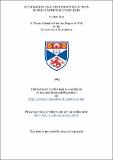Files in this item
Nitrosation and other studies of iron sulphur nitrosyl complexes
Item metadata
| dc.contributor.advisor | Glidewell, Christopher | |
| dc.contributor.author | Lees, Audrey | |
| dc.coverage.spatial | 196 p. | en_US |
| dc.date.accessioned | 2018-07-05T11:08:30Z | |
| dc.date.available | 2018-07-05T11:08:30Z | |
| dc.date.issued | 1993 | |
| dc.identifier.uri | https://hdl.handle.net/10023/14976 | |
| dc.description.abstract | A structure for the selenium analogue of the Roussin's black anion, [Fe₄S₃(NO)₇]⁻ had been proposed, on the basis of ¹⁵N.N.M.R. spectroscopy results, as being similar to that of the sulphur molecule. X-Ray crystallography was carried out on a crystal of Ph₄AS Fe₄Se ₃(NO)₇]⁻ to determine whether this conclusion was correct. The crystal, Mr=1053.67, was triclinic of space group p1̅ with a=13.122 (9), b=13.936 (9), c=9.908 (8)A, α =99.30 (6), β =97.04 (6), γ=71.94 (5)° and Z=2. This structure was refined from diffractometer data to an R value of 0.047 and was found to consist of isolated Ph₄As+ cations and [Fe₄Se₃(NO)₇]⁻ anions which exhibit approximate C3v symmetry, and agrees with that deduced from earlier work. It was also found that the capping influences the size of the Fe₄ cage. Nitrosation studies of amines by iron sulphur nitrosyl clusters had reached a variety of conflicting conclusions; i.e. that no anaerobic nitrosation occurred and that the formation of solvocomplexes may or may not have been important in the nitrosation mechanism. An investigation was undertaken using tetranuclear, dinuclear and mononuclear iron sulphur nitrosyl complexes in a variety of atmospheres and solvents with amines of different basicities. It was found that tetranuclear clusters do not nitrosate amines readily and that solvocomplex formation is not important in nitrosation by tetranuclear clusters. The cluster does require to be oxidised however. Only morpholine and pyrrolidine, both of which were capable of forming mononuclear solvocomplexes themselves, were nitrosated by dinuclear clusters and it is thought that the formation of solvocomplexes is important to nitrosation by di-iron species, which was found to occur as readily in an atmosphere of nitrogen as in air. These amines were also nitrosated by mononuclear iron complexes and it was found that the dinitrito species [Fe(N0)₂(N₂)₂]- did not nitrosate amines more readily than other monoiron sulphur nitrosyl complexes. Fragmentation and reassembly is thought to be the likely mechanism of conversion of the Roussin's black salt anion, [Fe₄S₃(NO)₇]-, to the cubane-type cluster, although mixed cluster experiments were found to be invalid for these studies because the black salt anion spontaneously converts to the cubane-type cluster on refluxing it in toluene. Experiments done to investigate the likely mechanism of the methylation of [Fe(SH)₂(NO)₂]- found that reactions with bromopentane, which would cause the sulphur atom to be methylated, and pentanethiol, which would attack the metal atom, both gave the same product. Chapter One summaries the history and development of iron sulphur nitrosyl chemistry and provides an introduction to the biological aspects of this field of work. Chapter Two describes the crystal structure determination of tetraphenylarsonium heptanitrosyl-tri-µ3-seleno tetraferrate (1-). Chapter Three provides an account of a study of the nitrosation of amines by iron sulphur nitrosyl complexes of various nuclearities and suggests mechanisms for and limitations on their nistrosating ability. In Chapter Four is to be found a description of two other lines of research which were undertaken; a study of the mechanism of the conversion of [Fe₄S₃(NO)₇]⁻ to [Fe₄s₄(no)₄] and an investigation of the methylation of [Fe(SH)₂(NO)₂]⁻. Chapter Five contains a description of all preparations used during the work. | en_US |
| dc.language.iso | en | en_US |
| dc.publisher | University of St Andrews | |
| dc.subject.lcc | QD305.N8L3 | |
| dc.subject.lcsh | Nitro compounds | en |
| dc.title | Nitrosation and other studies of iron sulphur nitrosyl complexes | en_US |
| dc.type | Thesis | en_US |
| dc.type.qualificationlevel | Doctoral | en_US |
| dc.type.qualificationname | PhD Doctor of Philosophy | en_US |
| dc.publisher.institution | The University of St Andrews | en_US |
This item appears in the following Collection(s)
Items in the St Andrews Research Repository are protected by copyright, with all rights reserved, unless otherwise indicated.

